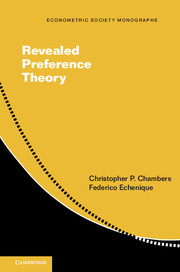Book contents
- Frontmatter
- Dedication
- Contents
- Preface
- 1 Mathematical Preliminaries
- 2 Classical Abstract Choice Theory
- 3 Rational Demand
- 4 Topics in Rational Demand
- 5 Practical Issues in Revealed Preference Analysis
- 6 Production
- 7 Stochastic Choice
- 8 Choice Under Uncertainty
- 9 General Equilibrium Theory
- 10 Game Theory
- 11 Social Choice and Political Science
- 12 Revealed Preference and Systems of Polynomial Inequalities
- 13 Revealed Preference and Model Theory
- References
- Index
- Miscellaneous Endmatter
Preface
Published online by Cambridge University Press: 05 January 2016
- Frontmatter
- Dedication
- Contents
- Preface
- 1 Mathematical Preliminaries
- 2 Classical Abstract Choice Theory
- 3 Rational Demand
- 4 Topics in Rational Demand
- 5 Practical Issues in Revealed Preference Analysis
- 6 Production
- 7 Stochastic Choice
- 8 Choice Under Uncertainty
- 9 General Equilibrium Theory
- 10 Game Theory
- 11 Social Choice and Political Science
- 12 Revealed Preference and Systems of Polynomial Inequalities
- 13 Revealed Preference and Model Theory
- References
- Index
- Miscellaneous Endmatter
Summary
WHAT IS REVEALED PREFERENCE THEORY?
“Revealed preference” is a term with several interpretations in economic theory, all closely related but possessing subtle philosophical differences. The central theme common to all interpretations is that of understanding what economic models say about the observable world. Most practitioners of revealed preference theory recognize that an economic model is useful for organizing data and making predictions, but they would not go so far as to admit that the model is, or represents, “reality.” Economic models usually consist of multiple interacting parts. Some parts are theoretical in nature, and are not meant to be observed. These unobservable parts are then tied to objects which could potentially be observed and measured.
Let us begin with the canonical example of revealed preference theory. Economists often view individuals as making decisions consistent with some objective function, usually interpreted as “utility.” So, the theory posits that an individual chooses that option which gives her the highest utility among all feasible options. This has proved to be a useful and tractable model in many branches of economics; in fact, the concept is ubiquitous. But it has been recognized at least since Pareto (1906) that, even if an individual optimizes a utility, the cardinal structure of said utility function (that is, the numerical values assigned to potential choices by the utility) cannot be inferred from choice behavior. Utility is a “theoretical” concept. The only empirically meaningful statements that can be gleaned from data relate to whether one option exhibits a higher utility than another. Once this is recognized, it is natural to ask: what are the predictions of the utility maximization model for observable choice behavior? Obviously, the predictions will have to be made across different choice situations. A theory that claims an individual chooses the best available option from those in front of her will have little to say without imposing constraints on the notion of “best.” So, the next step was to understand what these predictions are. These questions form the first few chapters of this book.
The revealed preference approach seeks to understand what a given model says about data. Observable economic data are either consistent with a given model or not.
- Type
- Chapter
- Information
- Revealed Preference Theory , pp. xiii - xxPublisher: Cambridge University PressPrint publication year: 2016



